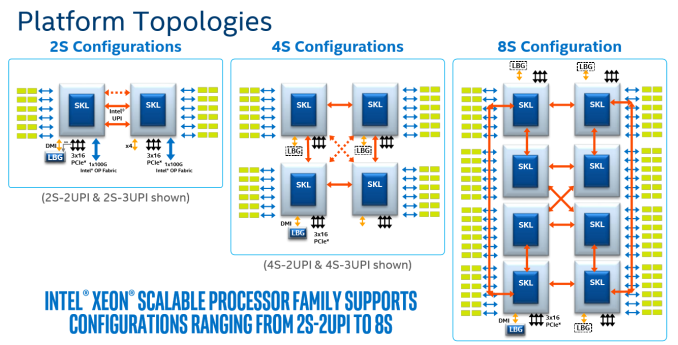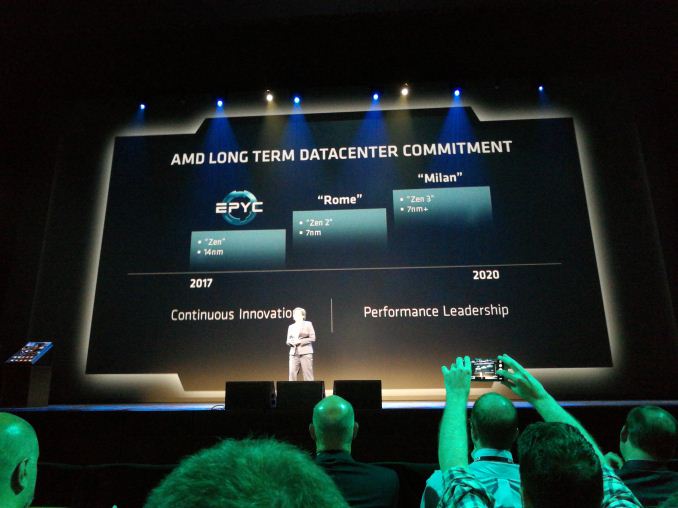Sizing Up Servers: Intel's Skylake-SP Xeon versus AMD's EPYC 7000 - The Server CPU Battle of the Decade?
by Johan De Gelas & Ian Cutress on July 11, 2017 12:15 PM EST- Posted in
- CPUs
- AMD
- Intel
- Xeon
- Enterprise
- Skylake
- Zen
- Naples
- Skylake-SP
- EPYC
Closing Thoughts
First of all, we have to emphasize that we were only able to spend about a week on the AMD server, and about two weeks on the Intel system. With the complexity of both server hardware and especially server software, that is very little time. There is still a lot to test and tune, but the general picture is clear.
We can continue to talk about Intel's excellent mesh topology and AMD strong new Zen architecture, but at the end of the day, the "how" will not matter to infrastructure professionals. Depending on your situation, performance, performance-per-watt, and/or performance-per-dollar are what matters.
The current Intel pricing draws the first line. If performance-per-dollar matters to you, AMD's EPYC pricing is very competitive for a wide range of software applications. With the exception of database software and vectorizable HPC code, AMD's EPYC 7601 ($4200) offers slightly less or slightly better performance than Intel's Xeon 8176 ($8000+). However the real competitor is probably the Xeon 8160, which has 4 (-14%) fewer cores and slightly lower turbo clocks (-100 or -200 MHz). We expect that this CPU will likely offer 15% lower performance, and yet it still costs about $500 more ($4700) than the best EPYC. Of course, everything will depend on the final server system price, but it looks like AMD's new EPYC will put some serious performance-per-dollar pressure on the Intel line.
The Intel chip is indeed able to scale up in 8 sockets systems, but frankly that market is shrinking fast, and dual socket buyers could not care less.
Meanwhile, although we have yet to test it, AMD's single socket offering looks even more attractive. We estimate that a single EPYC 7551P would indeed outperform many of the dual Silver Xeon solutions. Overall the single-socket EPYC gives you about 8 cores more at similar clockspeeds than the 2P Intel, and AMD doesn't require explicit cross socket communication - the server board gets simpler and thus cheaper. For price conscious server buyers, this is an excellent option.
However, if your software is expensive, everything changes. In that case, you care less about the heavy price tags of the Platinum Xeons. For those scenarios, Intel's Skylake-EP Xeons deliver the highest single threaded performance (courtesy of the 3.8 GHz turbo clock), high throughput without much (hardware) tuning, and server managers get the reassurance of Intel's reliable track record. And if you use expensive HPC software, you will probably get the benefits of Intel's beefy AVX 2.0 and/or AVX-512 implementations.
The second consideration is the type of buyer. It is clear that you have to tune more and work harder to get the best performance out of AMD EPYC CPUs. In many ways it is basically a "virtual octal socket" solution. For enterprises with a small infrastructure crew and server hardware on premise, spending time on hardware tuning is not an option most of the time. For the cloud vendors, the knowledge will be available and tuning for EPYC will be a one-time investment. Microsoft is already deploying AMD's EPYC in their Azure Cloud Datacenters.
Looking Towards the Future
Looking towards the future, Intel has the better topology to add more cores in future CPU generations. However AMD's newest core is a formidable opponent. Scalar floating point operations are clearly faster on the AMD core, and integer performance is – at the same clock – on par with Intel's best. The dual CCX layout and quad die setup leave quite a bit of performance on the table, so it will be interesting how much AMD has learned from this when they launch the 7 nm "Rome" successor. Their SKU line-up is still very limited.
All in all, it must be said that AMD executed very well and delivered a new server CPU that can offer competitive performance for a lower price point in some key markets. Server customers with non-scalar sparse matrix HPC and Big Data applications should especially take notice.
As for Intel, the company has delivered a very attractive and well scaling product. But some of the technological advances in Skylake-SP are overshadowed by the heavy price tags and somewhat "over the top" market segmentation.












219 Comments
View All Comments
Shankar1962 - Wednesday, July 12, 2017 - link
AMD is fooling everyone one by showing more cores, pci lanes, security etcCan someone explain me why GOOGLE ATT AWS ALIBABA etc upgraded to sky lake when AMD IS SUPERIOR FOR HALF THE PRICE?
Shankar1962 - Wednesday, July 12, 2017 - link
Sorry its BaiduPretty sure Alibaba will upgrade
https://www.google.com/amp/s/seekingalpha.com/amp/...
PixyMisa - Thursday, July 13, 2017 - link
Lots of reasons.1. Epyc is brand new. You can bet that every major server customer has it in testing, but it could easily be a year before they're ready to deploy.
2. Functions like ESXi hot migration may not be supported on Epyc yet, and certainly not between Epyc and Intel.
3. Those companies don't pay the same prices we do. Amazon have customised CPUs for AWS - not a different die, but a particular spec that isn't on Intel's product list.
There's no trick here. This is what AMD did before, back in 2006.
blublub - Tuesday, July 11, 2017 - link
I kinda miss Infinity Fabric on my Haswell CPU and it seems to only have on die - so why is that missing on Haswell wehen Ryzen is an exact copy?blublub - Tuesday, July 11, 2017 - link
argh that post did get lost.zappor - Tuesday, July 11, 2017 - link
4.4.0 kernel?! That's not good for single-die Zen and must be even worse for Epyc!AMD's Ryzen Will Really Like A Newer Linux Kernel:
https://www.phoronix.com/scan.php?page=news_item&a...
Kernel 4.10 gives Linux support for AMD Ryzen multithreading:
http://www.pcworld.com/article/3176323/linux/kerne...
JohanAnandtech - Friday, July 21, 2017 - link
We will update to a more updated kernel once the hardware update for 16.04 LTS is available. Should be August according to Ubuntukwalker - Tuesday, July 11, 2017 - link
You mention an OpenFOAM benchmark when talking about the new mesh topology but it wasn't included in the article. Any way you could post that? We are trying to evaluate EPYC vs Skylake for CFD applications.JohanAnandtech - Friday, July 21, 2017 - link
Any suggestion on a good OpenFoam benchmark that is available? Our realworld example is not compatible with the latest OpenFoam versions. Just send me an e-mail, if you can assist.Lolimaster - Tuesday, July 11, 2017 - link
AMD's lego design where basically every CCX can be used in whatever config they want be either consumer/HEDT or server is superior in the multicore era.Cheaper to produce, cheaper to sell, huge profits.